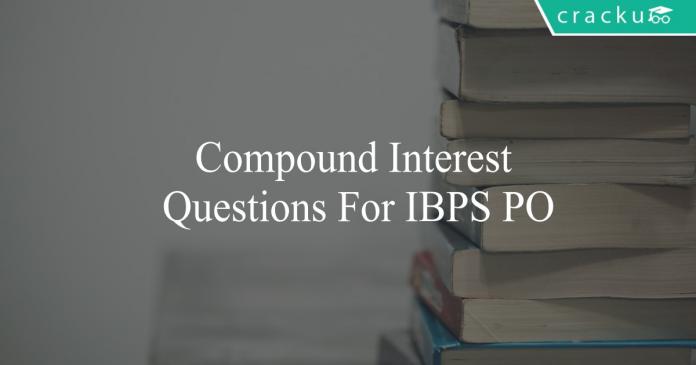Download Compound Interest Questions For IBPS PO
Take a free mock test for IBPS PO
Download IBPS PO Previous Papers PDF
Question 1: What is the compound interest obtained on a sum of 1200 after two years, if the rate of interest for the first year is 5% and for the second year is 10%?
a) Rs 186
b) Rs 210
c) Rs 194
d) Rs 152
e) None of these
Question 2: If Rs 18000 is invested in both simple interest and compound interest, what is the difference in interest after 2 years? Note that the interest in both the cases is equal to 10%.
a) Rs.180
b) Rs.200
c) Rs.360
d) Rs.400
e) none of these
Question 3: Amit and Mohit, both deposit Rs 67500 in a bank which offers 10% interest yearly for simple interest and 6% interest yearly for compound interest which is compounded half yearly. Amit opted for simple interest scheme while Mohit opted for compound interest scheme. After n years, Amit’s balance doubles in value. What is the ratio of Mohit’s balance after n years to the amount he deposited?
a) $(1+\frac{6}{100})^{20}$
b) $(1+\frac{3}{100})^{20}$
c) $(1+\frac{6}{100})^{10}$
d) $(1+\frac{3}{100})^{10}$
e) None of these
IBPS PO Quant Formulas & Shortcuts
Question 4: Harilal is a money lender who borrows money from the bank at a simple interest rate of 20%. He then lends it to people at an interest rate of 25% compounded annually and returns the money to bank as soon as he gets it back from his borrower. He borrowed Rs 1,00,000 from the bank and gave half of it to Ram and rest of it to Shyam. Ram returned the money with interest after 1 year, while Shyam returned it after 2 years. How much money did Harilal made in the whole transaction?
a) Rs 6250
b) Rs 7250
c) Rs 10625
d) Rs 11250
e) None of these
Question 5: Find the difference between the compound interest and simple interest offered by bank for the principle of Rs 100000 at 10% per annum after 3 years.
a) 3000
b) 3100
c) 3500
d) 2900
e) 2500
Instructions
Calculate the quantity I and the quantity II on the basis of the given information then compare them and answer the following questions accordingly.
Question 6: Quantity I: A person invested certain amount in Scheme A which offers 5% Simple Interest. Had he invested in Scheme B which offers 5% Compound Interest, he would have earned Rs.100 more. Find the sum.
Quantity II: A lent Rs.25000 to B at 12% per annum Simple Interest for 2 years. B lent it to C at 8% per annum Simple Interest for 2 years. Find the profit of B.
a) Quantity I > Quantity II
b) Quantity I < Quantity II
c) Quantity I $\geq$ Quantity II
d) Quantity I $\leq$ Quantity II
e) Quantity I = Quantity II or The relationship between Quantity I and Quantity II cannot be established.
Instructions
Calculate the quantity I and the quantity II on the basis of the given information then compare them and answer the following questions accordingly.
Question 7: Quantity I: What is the compound interest of a sum of Rs.9720 when compounded annually at $11\frac{1}{9}$% for a period of 2 years?
Quantity II: Rs.1400
a) Quantity I > Quantity II
b) Quantity I < Quantity II
c) Quantity I $\leq$ Quantity II
d) Quantity I $\geq$ Quantity II
e) Quantity I = Quantity II or The relationship between Quantity I and Quantity II can’t be determined
Instructions
Calculate the quantity I and the quantity II on the basis of the given information then compare them and answer the following questions accordingly.
Question 8: Quantity I: What is the compound interest of a sum of Rs.6776 when compounded annually at $9\frac{1}{11}$% for a period of 2 years?
Quantity II: Rs.1288
a) Quantity I > Quantity II
b) Quantity I < Quantity II
c) Quantity I $\leq$ Quantity II
d) Quantity I $\geq$ Quantity II
e) Quantity I = Quantity II or The relationship between Quantity I and Quantity II can’t be determined
Instructions
Calculate the quantity I and the quantity II on the basis of the given information then compare them and answer the following questions accordingly.
Question 9: Quantity I: The difference between simple interest and compound interest on a certain sum of money at 5% interest in 2 years is Rs.3. Then find the principal.
Quantity II: Rs.1500
a) Quantity I > Quantity II
b) Quantity I < Quantity II
c) Quantity I $\leq$ Quantity II
d) Quantity I $\geq$ Quantity II
e) Quantity I = Quantity II or The relationship between Quantity I and Quantity II can’t be determined
IBPS PO Previous Papers (Download Pdf)
Instructions
Calculate the quantity I and the quantity II on the basis of the given information then compare them and answer the following questions accordingly.
Question 10: Quantity I: What is the principal if Rs.16800 of compound interest is accrued at an interest of 10% for 2 years compounded annually?
Quantity II: Rs.82000
a) Quantity I > Quantity II
b) Quantity I < Quantity II
c) Quantity I $\leq$ Quantity II
d) Quantity I $\geq$ Quantity II
e) Quantity I = Quantity II or The relationship between Quantity I and Quantity II can’t be determined
Instructions
In the following question, Quantity 1 and Quantity 2 are given. Calculate the values and compare them and then choose the option accordingly:
Question 11: Kabir has borrowed Rs. 5000 at the rate of 12% per annum compound interest from Guru. Kabir has lent the entire amount to Bhuvan at 15% per annum simple interest.
Quantity 1:The amount Kabir owes by the end of 2 years.
Quantity 2:The amount Kabir is owed by the end of 2 years.
a) Quantity 1 $>$ Quantity 2
b) Quantity 1 $<$ Quantity 2
c) Quantity 1 $\geq$ Quantity 2
d) Quantity 1 $\leq$ Quantity 2
e) Quantity 1 $=$ Quantity 2 or no relation can be established
Instructions
In the following question, Quantity 1 and Quantity 2 are given. Calculate the values and compare them and then choose the option accordingly
Question 12: Quantity 1: Interest earned on Rs.1000 invested at 10% p.a compound interest for 4 years (compounded annually)
Quantity 2:Interest earned on Rs.1000 invested at 20% p.a. compound interest for 2 years (compounded annually)
a) Quantity 1 $>$ Quantity 2
b) Quantity 1 $<$ Quantity 2
c) Quantity 1 $\geq$ Quantity 2
d) Quantity 1 $\leq$ Quantity 2
e) Quantity 1 $=$ Quantity 2 or no relation can be established
Instructions
In the following question, Quantity 1 and Quantity 2 are given. Calculate the values and compare them and then choose the option accordingly.
Question 13: Quantity 1: Simple interest earned on Rs.5125 at 6.75% p.a in three years.
Quantity 2: Compound interest earned on Rs.5125 at 9% in two years when compounded annually.
a) Quantity 1 $>$ Quantity 2
b) Quantity 1 $<$ Quantity 2
c) Quantity 1 $\geq$ Quantity 2
d) Quantity 1 $\leq$ Quantity 2
e) Quantity 1 $=$ Quantity 2 or no relation can be established
Instructions
In the following question, Quantity 1 and Quantity 2 are given. Calculate the values and compare them and then choose the option accordingly
Question 14: Quantity I: Interest earned by Shaktikanta by lending Rs. 10000 at 20% per year for 2 years compounding on a yearly basis.
Quantity II: Simple interest paid by Subhash on borrowing Rs. 6000 at 30% per year for 2 years.
a) Quantity 1 $>$ Quantity 2
b) Quantity 1 $<$ Quantity 2
c) Quantity 1 $\geq$ Quantity 2
d) Quantity 1 $\leq$ Quantity 2
e) Quantity 1 $=$ Quantity 2 or no relation can be established
Instructions
Calculate the Quantity I and the Quantity II on the basis of the given information then compare them and answer the following questions accordingly.
Question 15: Quantity I: Interest earned by Ratan by lending Rs. 8000 at 40% per year for 1.5 years compounding on a half-yearly basis.
Quantity II: Profit made by Russell by selling a laptop at 10% less than the marked price which he bought for Rs 15000 and marked up price by 38%.
a) Quantity 1 = Quantity 2
b) Quantity 1 $\geq$ Quantity 2
c) Quantity 1 $\leq$ Quantity 2
d) Quantity 1 > Quantity 2
e) Quantity 1 < Quantity 2
Instructions
In the following question, Quantity 1 and Quantity 2 are given. Calculate the values and compare them and then choose the option accordingly.
Question 16: Quantity 1: Simple interest earned on Rs.4962 at 6.75% p.a in three years.
Quantity 2: Compound interest earned on Rs.4962 at 10% in two years when compounded annually.
a) Quantity 1 $>$ Quantity 2
b) Quantity 1 $<$ Quantity 2
c) Quantity 1 $\geq$ Quantity 2
d) Quantity 1 $\leq$ Quantity 2
e) Quantity 1 $=$ Quantity 2 or no relation can be established
Instructions
Calculate the Quantity I and the Quantity II on the basis of the given information then compare them and answer the following questions accordingly.
Question 17: Quantity I: Interest paid by Kabir on borrowing Rs. 8000 at 20% per year for 2 years compounding on yearly basis.
Quantity II: Loss incurred by Amir if the cost price of a mobile is Rs. 6000 on which he marked up the price by 25% and offered a discount of 60%.
a) Quantity 1 = Quantity 2
b) Quantity 1 $\geq$ Quantity 2
c) Quantity 1 $\leq$ Quantity 2
d) Quantity 1 > Quantity 2
e) Quantity 1 < Quantity 2
Instructions
In the following question, Quantity 1 and Quantity 2 are given. Calculate the values and compare them and then choose the option accordingly.
Question 18: Quantity 1: Simple interest earned on Rs.3576 at 8% p.a in three years.
Quantity 2: Compound interest earned on Rs.3576 at 10% in two years when compounded annually.
a) Quantity 1 $>$ Quantity 2
b) Quantity 1 $<$ Quantity 2
c) Quantity 1 $\geq$ Quantity 2
d) Quantity 1 $\leq$ Quantity 2
e) Quantity 1 $=$ Quantity 2 or no relation can be established
Instructions
Calculate the Quantity I and the Quantity II on the basis of the given information then compare them and answer the following questions accordingly.
Question 19: Quantity I: Interest earned by Ram by lending Rs. 6000 at 15% per year for 2 years compounding on yearly basis.
Quantity II: Profit earned by Kishan by selling a toy in Rs. 8000 on which he marked up the price by 25%.
a) Quantity 1 = Quantity 2
b) Quantity 1 $\geq$ Quantity 2
c) Quantity 1 $\leq$ Quantity 2
d) Quantity 1 > Quantity 2
e) Quantity 1 < Quantity 2
Instructions
In the following question, Quantity 1 and Quantity 2 are given. Calculate the values and compare them and then choose the option accordingly.
Question 20: Quantity 1: Rate at which simple interest earned on Rs.5000 in two years is Rs.800.
Quantity 2: Rate at which compound interest earned on Rs.1000 in three years is Rs.331.
a) Quantity 1 $>$ Quantity 2
b) Quantity 1 $<$ Quantity 2
c) Quantity 1 $\geq$ Quantity 2
d) Quantity 1 $\leq$ Quantity 2
e) Quantity 1 $=$ Quantity 2 or no relation can be established
IBPS PO Important Questions PDF
Free Banking Study Material (15,000 Solved Questions
Answers & Solutions:
1) Answer (A)
The value of the sum at the end of two years = 1200(1.05)*(1.1) = 1386
Therefore compound interest obtained = 1386-1200 = Rs 186
So the correct option to choose is A – Rs 186.
2) Answer (A)
When an amount is invested in both S.I and C.I, the interest will be the same in the first year. In the second year, money invested in C.I will also charge interest on the interest accrued in the first year. Thus, the interest on the interest of the 1st year is the difference between S.I and C.I for two years.
The interest obtained in the 1st year = Rs. 1800 x 10% = Rs. 1800
The interest charged on Rs. 1800 = 1800 x 10% = Rs. 180
Thus, the required difference = Rs.180
3) Answer (B)
Let P=Rs 67500
Now, for Amit, P(1+nr/100)=2P
= nr/100=1
r=10
=> n=10
Mohit’s balance after n years will be $P(1+\frac{3}{100})^{20}$ since the interest is 6% which is compounded half yearly. So the time period that we will take is 20.
So the ratio will be $(1+\frac{3}{100})^{20}$
4) Answer (C)
Total money that Ram returned to Harilal is:$50000\times(1+\frac{25}{100})^{1}$
Total money that Harilal returned to bank is simple interest on principle for 1 year + principle =$50000\times(1+\frac{20*1}{100})$
Profit on Ram’s transaction is: $50000\times(\frac{25-20}{100})=Rs 2500$
Money that Shyam returned to Harilal is $50000\times(1+\frac{25}{100})^{2}=50000\times(\frac{25}{16})=50000\times(1+\frac{9}{16})$
Total money that Harilal returned to bank is simple interest on principle for 2 year + principle =$50000\times(1+\frac{20*2}{100})=50000\times(1+\frac{4}{10})$
Profit on Shyam’s transaction is: $50000\times(\frac{9}{16}-\frac{4}{10})=50000\times(\frac{13}{80})=Rs 8125 $
Total Money made is Rs 8125 + Rs 2500= Rs 10625
5) Answer (B)
SI = P*R*T/100 = 100000*10*3/100 = 30000
CI = P$(1+r/100)^n$-P =$100000(1.1)^3-100000$ = 133100-100000 = 33100
Difference = 33100-30000 = 3100
6) Answer (A)
Quantity I:
Let the principal be Rs.10000
Simple Interest at 5% SI for 2 years = $\dfrac{10000\times5\times2}{100} = Rs.1000$
Amount for 1 year at 5% CI = 105% of Rs.10000 = Rs.10500
Amount for 2 years at 5% CI = 105% of Rs.10500 = Rs.11025
Total Compound Interest = Rs.11025 – Rs.10000 = Rs.1025
Difference between SI and CI = Rs.1025 – Rs.1000 = Rs.25
Given that the difference = Rs.100
Rs.25 → Rs.100
Rs.10000 → ?
= $\dfrac{10000\times100}{25} = Rs.40000$
Hence, Principal = Rs.40000
Quantity II:
Profit of B = $\dfrac{25000\times12\times2}{100} – \dfrac{25000\times8\times2}{100} = Rs.6000 – Rs.4000 = Rs.2000$
Therefore, Quantity I > Quantity II
7) Answer (A)
Quantity I: Given Principal = Rs.9720
Time Period = 2 years
Rate of interest = $11\frac{1}{9}$%.
$11\frac{1}{9}$ = $\frac{100}{9}$%
Compound Interest at the end of 1 year $= 9720\times\dfrac{100}{9}\times\dfrac{1}{100} = Rs.1080$
Amount at the end of 1st year $= 9720+1080 = Rs.10800$
Compound Interest at the end of 2nd year $= 10800\times\dfrac{100}{9}\times\dfrac{1}{100} = Rs.1200$
Amount at the end of 2nd year $= 10800+1200 = Rs.12000$
Compound Interest for 2 years $= Rs.12000-Rs.9720 = Rs.2280$
Quantity II: $Rs.1400$
Hence, Quantity I > Quantity II
8) Answer (E)
Quantity I:
Given Principal = Rs.6776
Rate of Interest = $9\frac{1}{11}$% = $\frac{1}{11}$
Time period = 2 years
Compound Interest at the end of 1 year $= 6776\times\frac{1}{11} = Rs.616$
Amount at the end of 1 year = 6776+616 = Rs.7392
Compound Interest at the end of 2 years $= 7392\times\frac{1}{11} = Rs.672$
Amount at the end of 2 years = 7392+672 = Rs.8064
Therefore, Compound Interest = 8064-6776 = Rs.1288
Quantity II: Rs.1288
Hence, Quantity I = Quantity II
9) Answer (B)
Quantity I: Let the principal amount be Rs.10000
Then, Simple Interest $= \frac{10000\times2\times5}{100} = 1000$
Amount at the end of 1st year at 5% compound interest = Rs.$10500$
Amount for $2$ years $=$ Rs.$11025$
Compound Interest $= 11025 – 10000 =$ Rs.$1025$
Difference between SI and CI $= 1025 – 1000 =$ Rs.$25$
Given that the difference $=$ Rs.$3$
$25\rightarrow3$
$10000\rightarrow?$
=> $\frac{10000\times3}{25} = 1200$
Therefore, principal = Rs.$1200$
Quantity II: Rs.1500
Hence, Quantity I < Quantity II
10) Answer (B)
Quantity I: Let the principal amount be Rs.100
Amount at the end of 1 year at 10% compound interest = Rs.110
Amount at the end of 2 years = Rs.121
Compound interest = 121-100 = Rs.21
Given Compound Interest = Rs.16800
21 → 16800
100 → ?
= $\frac{100\times16800}{21} = 80000$
Hence, Principal = Rs.80000
Quantity II: Rs.82000
Hence, Quantity I < Quantity II
11) Answer (B)
Since Kabir lends the entire amount, the principal is immaterial. Let us assume the principal to be ‘p’.
The money that Kabir has borrowed will amount to p*1.12*1.12 = 1.2544*p
Kabir has lent the entire amount at 15% SI. Kabir will get back p + 2*0.15*p = 1.3p
As we can see, the amount that Kabir is owed is greater than the amount that Kabir owes. Therefore, quantity 2 is greater than quantity 1 and hence, option B is the right answer.
12) Answer (A)
Since the principal is the same in both the cases, we will compare the amounts by the end of the given periods.
Quantity 1:
Rs.1000 invested at 10% p.a compound interest for 4 years will amount to $1000*(1.1)^4$ = $1.4641*1000$
Quantity 2:
Rs.1000 invested at 20% p.a. compound interest for 2 years will amount to $1000*(1.2)^2$ = $1.44*1000$
As we can see, quantity 1 is greater than quantity 2 and hence, option A is the right answer.
13) Answer (A)
Quantity 1 = Rs.$\dfrac{5125 * 6.75 * 3}{100}$ = Rs.1037.80.
Quantity 2 = Rs.(5125 * 1.09 * 1.09 – 5125) = Rs.964
Thus, Quantity 1 is greater than Quantity 2.
Hence, option A is the correct answer.
14) Answer (A)
Quantity I: Compounded interest earned by Shaktikanta = $10000*(1+\dfrac{20}{100})^{2} – 10000$ = Rs. 4400
Quantity II: Simple interest paid by Subhash on Rs. 6000 at 30% per year for 2 years = 6000*0.30*2/100 = Rs. 3600
Hence, we can say that Quantity 1 > Quantity 2.
15) Answer (D)
Quantity I: Compounded interest earned by Ratan = $8000*(1+\dfrac{40/2}{100})^{2*1.5} – 8000$ = Rs. 5824
Quantity II: cost price = Rs. 15000, Mark-up percentage = 38%
Therefore, the marked price of the product = 1.38*15000 = Rs. 20700
Hence, the selling price of the product = (1-0.1)*20700 = Rs. 18630
Hence, the profit made by Russell = 18630 – 15000 = Rs. 3630
Hence, we can say that Quantity 1 > Quantity 2.
16) Answer (B)
Quantity 1 = $\dfrac{4962 * 6.75 * 3}{100} = 4962 \times \dfrac{20.25}{100} = 4062 \times (0.2025) $
Quantity 2 = $ 4962 \times [(1.1)^{2} – 1] = 4962 \times (0.21) $
Since 4962 is same, we just need to compare the term on the right to compare the value of the expression.
Thus, Quantity 2 is greater than Quantity 1.
Hence, option B is the correct answer.
17) Answer (D)
Quantity I: Compounded interest paid by Kabir = $8000*(1+\dfrac{20}{100})^2 – 8000$ = Rs. 3520
Quantity II: cost price = Rs. 6000, Mark-up percentage = 25%
Therefore, the marked price of the product = 1.25*6000 = Rs. 7500
Hence, the selling price of the product = (1-0.6)*7500 = Rs. 3000
Hence, the loss incurred by Amir = 6000 – 3000 = Rs. 3000
Hence, we can say that Quantity 1 > Quantity 2.
18) Answer (A)
Quantity 1 = $\dfrac{3576 \times 8 \times 3}{100} = 3576 \times \dfrac{24}{100} = 3576 \times (0.24)$
Quantity 2 = $3576 \times [(1.1)^{2} – 1] = 3576 \times (0.21) $
Since 3576 is common, we just compare the second terms in the expression.
Thus, Quantity 1 is greater than Quantity 2.
Hence, option A is the correct answer.
19) Answer (D)
Quantity I: Compounded interest earned by Ram = $6000*(1+\dfrac{15}{100})^2 – 6000$ = Rs. 1935
Quantity II: Marked price = Rs. 8000, Mark-up percentage = 25%
Therefore, the cost price of the product = $\dfrac{100}{100+25}\times 8000$ = Rs. 6400
Hence, the profit amount made by Kishan = 8000 – 6400 = Rs. 1600
Hence, we can say that Quantity 1 > Quantity 2.
20) Answer (E)
Quantity 1 = Rs.$\dfrac{800 * 100}{5000 * 2}$ = 8%
Quantity 2 cannot be calculated because the frequency of compounding is not given.
Hence, option E is the correct answer.





